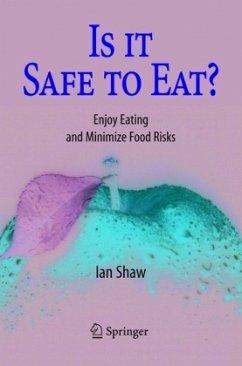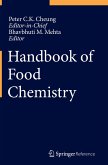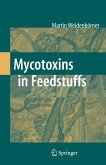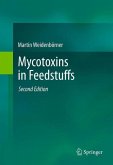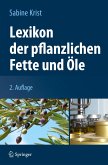Does your perception of food risks closely mirror the real risks? The reality is not what you think it is! Nobody would expect to die of cyanide poisoning after eating an almond cake - but if you tell them there is cyanide in it, they might think at least twice about eating it. Do you know that you are spreading an aerosol of Camphylobacter bacteria around your kitchen and on other food that may lay around - and thus creating possibly life-threatening toxins - just by washing an oven-ready chicken from the supermarket before roasting it?
The author, Ian Shaw, PhD, discusses all these and many other important problems and questions - ranging from GM food to natural toxins - in his easily understandable, passionate, yet authoritative and informative book. But in contrast to many other authors, Ian Shaw sets the risks of food, foodborne pathogens and food contaminats in the context of life's risks. Enjoyment of food and eating is a benefit that far outweighs the risks, atleast if everybody is aware of those risks and uses measures to minimize them.
The author, Ian Shaw, PhD, discusses all these and many other important problems and questions - ranging from GM food to natural toxins - in his easily understandable, passionate, yet authoritative and informative book. But in contrast to many other authors, Ian Shaw sets the risks of food, foodborne pathogens and food contaminats in the context of life's risks. Enjoyment of food and eating is a benefit that far outweighs the risks, atleast if everybody is aware of those risks and uses measures to minimize them.
From the reviews:
"Ian Shaw's book draws to our attention some of the horrors lurking in seemingly harmless food. ... Shaw addresses many other food-related issues, including the role of prions in BSE-infected meat, xenoestrogens and declining sperm counts, food-borne bacteria and viruses, and the use of genetically modified food." (Dennis Rouvray, Chemistry World, Vol. 20(9), September, 2005)
"Does your perception of food risks closely mirror the real risks? ... The author Professor Ian Shaw, discusses these important issues and questions in his easily understandable, passionate, yet authoritative and informative book. ... Ian Shaw sets the risks of food, foodborne pathogens and food contaminants in the context of life's other risks." (Food Trade Review, Vol. 75, May, 2005)
"Professor Dr Ian Shaw candidly points out that food is just one of life's risks, and he admits that he hopes that, as readers, we will make up our own minds about risk. ... This is a most readable book, which helps us look beyond the headlines." (Susan Omar, Biologist, Vol. 53 (3), 2006)
"This book is an overview of food safety related to the personal experiences of the author. ... this book is recommended to everybody interested in food and food safety, culinary science or cooking, that means cooks, farmers, growers, bakers, food processors, professionals and students in food technology, food chemistry and biology; food information specialists, and also media professionals." (Advances in Food Science, Vol. 27 (4), 2005)
"This book provides a very good introduction to the safety of out food supply. ... The presentation is clear with an appropriate balance between biological and chemical risks. ... The book should be recommended reading for students in a wide range of courses. It is written in a style that is both readable and readily understood, so it should also appeal to and inform a much wider audience on a topic so prone to misunderstandingsand sensational-headlines." (Darryl M. Small, Magazine of the Royal Australian Chemical Institute, July, 2005)
"Ian Shaw's book draws to our attention some of the horrors lurking in seemingly harmless food. ... Shaw addresses many other food-related issues, including the role of prions in BSE-infected meat, xenoestrogens and declining sperm counts, food-borne bacteria and viruses, and the use of genetically modified food." (Dennis Rouvray, Chemistry World, Vol. 20(9), September, 2005)
"Does your perception of food risks closely mirror the real risks? ... The author Professor Ian Shaw, discusses these important issues and questions in his easily understandable, passionate, yet authoritative and informative book. ... Ian Shaw sets the risks of food, foodborne pathogens and food contaminants in the context of life's other risks." (Food Trade Review, Vol. 75, May, 2005)
"Professor Dr Ian Shaw candidly points out that food is just one of life's risks, and he admits that he hopes that, as readers, we will make up our own minds about risk. ... This is a most readable book, which helps us look beyond the headlines." (Susan Omar, Biologist, Vol. 53 (3), 2006)
"This book is an overview of food safety related to the personal experiences of the author. ... this book is recommended to everybody interested in food and food safety, culinary science or cooking, that means cooks, farmers, growers, bakers, food processors, professionals and students in food technology, food chemistry and biology; food information specialists, and also media professionals." (Advances in Food Science, Vol. 27 (4), 2005)
"This book provides a very good introduction to the safety of out food supply. ... The presentation is clear with an appropriate balance between biological and chemical risks. ... The book should be recommended reading for students in a wide range of courses. It is written in a style that is both readable and readily understood, so it should also appeal to and inform a much wider audience on a topic so prone to misunderstandingsand sensational-headlines." (Darryl M. Small, Magazine of the Royal Australian Chemical Institute, July, 2005)

